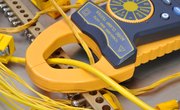
A simple do-it-yourself 60 Hertz quartz oscillator won't be simple if you try to build it with a 60 Hertz quartz crystal, because there aren't quartz crystals that will generate a 60 Hertz frequency. When designers want to create a non-standard frequency, such as 60 Hertz, they use a high-frequency quartz crystal and a frequency divider. One very simple DIY implementation is to use a 3.58 MHz crystal and a 3.58 MHz to 60 Hz frequency converter chip.
- Electronic breadboard
- ELM 440 60 Hz Generator
- 27 picofarad capacitor (2)
- 3.58 MHz crystal quartz oscillator
- 0.1 microfarad capacitor
- Power supply (5 Volts)
If you want a visual way to show that your oscillator is working, divide the output of the ELM 440 with a divide by 60 frequency divider and connect a light emitting diode to the frequency divider's output (don't forget the current limiting resistor). The light emitting diode should blink on and off at a rate of 60 cycles per second after you power on.
Improper use of electronic equipment and components can result in fire, serious injury or death. Always work under the supervision of a safety certified electronic technician or electronic engineer. Obtain an electronic safety certificate before you work with electronic equipment and components.
Insert the ELM 440 3.58-to-60 Hertz frequency converter chip into your electronic breadboard. Wire the supply voltage (pin 1) of the ELM 440 to the breadboard's power bus. Wire the ground pins (pins 5 and 8) of the ELM 440 to the breadboard's ground bus.
Insert the 3.58 MHz quartz crystal into the breadboard. Wire one end of the crystal to pin 2 of the ELM 440 and the other end to pin 3.
Insert a 27 picofarad capacitor into the breadboard. Wire one end to pin 2 of the ELM 440 and the other end to the breadboard's ground bus.
Insert another 27 picofarad capacitor into the breadboard. Wire one end to pin 3 of the ELM 440 and the other end to the breadboard's ground bus.
Insert a 1 microfarad capacitor into the breadboard. Wire one end to pin 1 of the ELM 440 and the other end to the breadboard's power bus.
Connect the power supply's positive terminal to the breadboard's positive supply bus and the power supply's negative terminal to the breadboard's ground bus.
Turn on the power supply and adjust the power supply's voltage level knob until the power supply display reads 5 volts.
Things You'll Need
Tips
Warnings
References
Tips
- If you want a visual way to show that your oscillator is working, divide the output of the ELM 440 with a divide by 60 frequency divider and connect a light emitting diode to the frequency divider's output (don't forget the current limiting resistor). The light emitting diode should blink on and off at a rate of 60 cycles per second after you power on.
Warnings
- Improper use of electronic equipment and components can result in fire, serious injury or death. Always work under the supervision of a safety certified electronic technician or electronic engineer. Obtain an electronic safety certificate before you work with electronic equipment and components.
About the Author
Mark Stansberry has been a technical and business writer over for 15 years. He has been published in leading technical and business publications such as "Red Herring," "EDN" and "BCC Research." His present writing focus is on computer applications programming, graphic design automation, 3D linear perspective and fractal technology. Stansberry has a Bachelor of Science in electrical engineering from San Jose State University.
Photo Credits
Thinkstock/Comstock/Getty Images
